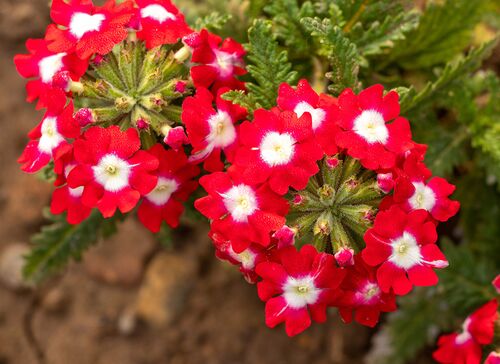Growing and Sowing of Verbena

Verbena, also known as vervain or verveine, is a strong, ornamental plant popular in gardens and borders. There are several varieties, each with its own characteristics. The
Verbena bonariensis, the purpletop vervain, is a tall plant that blooms from June to October with purple, small flowers in loose umbels. This species, which is very well known, attracts many bees and butterflies.
Verbena rigida or slender vervain is also a taller species with bright purple to blue-violet flowers, which are slightly larger than those of bonariensis. Verbena hastata, also called American vervain orblue vervain, can grow 80 to 2 metres tall and blooms with blue to purple flowers, in dense spikes. Verbena x hybrida, also called garden verbena, comes in different heights and colours. Verbena officinalis (medicinal vervain), which grows medium-sized and blooms with lavender-coloured flowers. This species is used in herbal medicine.
Sowing and growing Verbena
There are several types of Verbena, each of which has its own characteristics. Popular varieties are the Verbena bonariensis and the Verbena x hybrida. Most species are partly hardy, which means that they survive provided it is not too cold. Vervain can also spread easily.
Sowing Verbena Seeds
Sowing indoors can be done from March to April (in a greenhouse, propagator or on a warm windowsill).
Sowing outdoors can be done from May, when there is no more frost. Many varieties of Verbena are light germinators, so sow them on the ground and press lightly. Do not cover with soil. After this, keep the soil moist. When the seedlings are big enough to handle (2-3 true leaves), you can prick them out. Then plant them out at a planting distance of 30-40 cm. Smaller varieties can be planted closer together.
Position and soil for verbena flowers
Choose a sunny, warm spot with well-drained soil.
How to care for your Verbena plants
Verbena needs little care. Water regularly in dry periods, but avoid wet feet. The plants are reasonably drought-tolerant provided they are well-rooted.
Are Verbena plants bee and/or butterfly friendly?
Verbena is, depending on the species, bee- and butterfly-friendly. Most varieties bloom for a long time, contain a lot of nectar and have open flowers, making them easily accessible.
Verbena in the vegetable garden
Although, except for one species, it is not an edible plant, Verbena does have benefits for your vegetable garden, especially if you like to garden organically. It attracts bees, bumblebees, and butterflies, which helps with pollination. Moreover, they bloom for a long time and because of the shape they take away little light. Flowers in a vegetable garden increase biodiversity.
Is Verbena edible and/or medicinal?
Verbena is not edible, but also not poisonous, although it can lead to abdominal discomfort. Only the verbena officinalis is edible and is used in herbal medicine.
Please note, we at Dutch Garden Seeds do not give medical advice. Always ask a professional if and how the plant can be used medicinally.
Verbena Seeds in our collection
In our range, for example, we have a low-growing type of Verbena, in mixed colours, and a bee mixture that contains vervain. Both from the brand 'Buzzy Seeds'.
Tips for sowing verbena
- Regularly remove faded flowers. This will make the plant bloom for longer.



